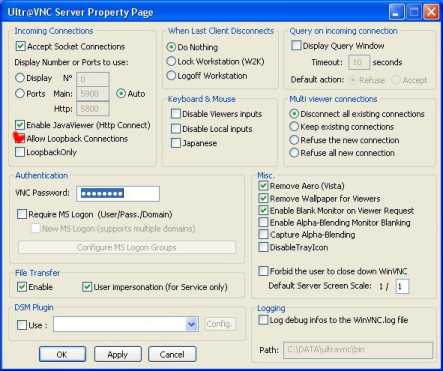Jan 23, 2018 I have setup screen sharing on the Mac however it asks me for a username and password when I try to connect. Does anyone know any VNC solutions that will allow us to connect to their screen without needing the users password/username to allow us to provide remote assistance?
In my case, I forgot the password to the VNC server. For my situation, the final target was TightVNC running on Ubuntu 18.04 which I needed to reach from my mac.You first kill the existing VNC sessions with vncserver -kill:1Use something like this to find out if you've killed all sessions. Usually, the vncserver is running on port 5901: sudo netstat -peanut grep 'vncserver'If there is something, repeat the kill command with the appropriate vncserver -kill:2 or whatever listing. If nothing, then you can remove the default original password setting with: sudo rm /.vnc/passwdRestart the vncserver as: vncserverAnd you'll be prompted again for a new password. The daemon should run on port 5901, which you can query with the netstat command above.
A little-known fact about Mac versions 10.4 (Tiger) and over, is that they come with a built-in VNC server. This feature is included in a couple of the “Sharing” options and can be accessed with a regular VNC viewer/client.However, when connecting from a Windows machine (particularly when running TightVNC as the viewer), I found I had to configure a few extra settings to make it work without constant freezes on my Mac, forcing me to hard reset. Here are some of the tweaks I had to make to ensure I could connect without issues. I am running 10.7.5 (Lion), so your steps may vary slightly.Firstly, you need to allow VNC connections. The two options are either Screen Sharing or Remote Management. Screen Sharing is what the “average” VNC user may need, while the latter is helpful if you need more permissions and control over the host machine. Allowing VNC connections:Step 1 – Go to your System Preferences and under the Internet and Wireless heading, click on Sharing.Step 2 – Enable either the Screen Sharing or the Remote Management checkboxes.Step 3 – Click on Computer Settings and enable “VNC viewers may control screen with password.”Step 4 – Provide a password and click “OK”.(Only for Remote Management)Step 5 – Click on Options and enable any other permissions you may need.You should now have a VNC server running on the standard port 5900 of your machine.
You should (in theory) be able to connect to your Mac with any viewer using your machine’s IP address and the port. As I mentioned before, I had some issues connecting from Windows, and had to take a few precautions. I’m using TightVNC, so these changes may or may not be necessary on other viewers. Tweaks for Windows:.
To prevent receiving a patterned, gray screen after the login, be sure to logout of your current user on your Mac first. The viewer will prompt for a password, but once connected, will not display the actual desktop unless no users are logged in on the host. In the Options menu:.
H.264 vfw codec install. And then choose a codec from the codec list, and then click the Configure button.A comparison between Bandicam Codec and External CodecThe table below shows the file sizes when Bandicam records a 1920x1080 resolution video for one minute. (FPS: 30, Quality: 80). Bandicam Codec.

Enable “Disable clipboard transfer.” This was a major issue that would cause freezing immediately upon on connect unless enabled. Of course, you will not be able to share the clipboard across the host and client machines, but at least the host machine will continue running properly. Set the “Preferred Encoding” to either “Raw” or “ZRLE”. The other options appeared to work, but seemed to cause some minor freeze-ups on the Mac. Oftentimes after closing the viewer, the Mac would freeze yet again, requiring a reset. One workaround is to click the “Pause” button (double red bar) in the active Viewer before closing the connection.
Have not yet gotten a chance to look into why this works, but it seems to solve the problem for the time being.Following these steps should help ensure you can connect to your Mac from a Windows machine. Just enter:5900 as the Remote Host and enter the password from before to connect.Of course, another option is to simply user a third-party VNC server, but if you don’t feel like installing more software, hopefully this should help in preventing a few headaches.Igor Shults.

